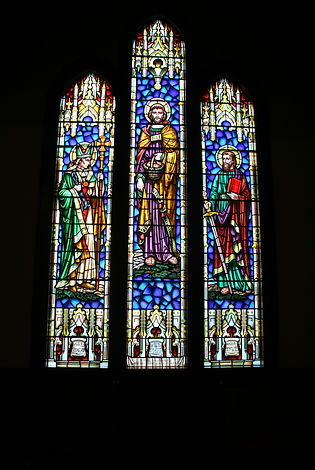
St. Philip the Apostle - Lemon Grove



Our History
Historic
Saint Philip the Apostle
Episcopal Church
The mission church of St. Philip the Apostle was founded in November of 1950 by Mary Ester Ray and a group of fifteen Episcopalians from St. Andrew’s Church in La Mesa. Membership grew, and by the time the mission became a parish in 1968, it was a well-established community with a worship hall, Sunday School classrooms, and a church office.
In 1969 the church learned that St. Dunstan’s was moving to a new location, and the Victorian building they’d occupied on the San Diego State University campus was going to be leveled to make room for a parking lot. Following emergency meetings of the Vestry and appeals to the administration at SDSU, it was agreed that if St. Philip’s could raise the money to move the church, our parish could have it.
The English Gothic Revival structure that today is St. Philip’s Church first opened its doors in 1887 in downtown San Diego at 8th Avenue and C Street as St. Paul’s Episcopal Church. Designed by Wilcox & Johnson of Minnesota, the church was part of the building boom of the 1880s. Some of the lumber used for its construction came from a load sent to build the famous Hotel Del Coronado. This beautiful church, with its tall steeple, vaulted ceilings and magnificent stained glass windows, remained a downtown landmark for six decades.
In time St. Paul’s outgrew this building, and in 1948 it was moved to the campus of San Diego State. There it was rechristened as St. Dunstan’s College Chapel, part of a new Episcopal church forming in the college area. The first service was held on Christmas Eve of 1948.
Two decades later, St. Dunstan’s congregation made plans to move and the old chapel was set for demolition. At the time the building was less than 100 years old, but Rev. Kenneth Johnson of St. Philip’s knew this lovely house of worship was worthy of preservation. After raising nearly $100,000, the congregation of St. Philips had the building moved in nine sections to our church property in Lemon Grove. There it was lovingly restored to its original condition by members who donated labor and money. On September 20, 1970, it began its new life as St. Philip the Apostle, and our original church building became the Parish Hall.
On March 18, 1972 the interior of the church was gutted by a fire, caused by a young boy playing with matches. Saddened but undaunted, Rev. Johnson hung up a sign declaring “We shall Re-Build.” Parishioners again rallied to restore the church, and on June 16, 1974 it was rededicated by the Rt. Rev. Robert M. Wolterstorff, the first Bishop of San Diego.
The nave of St. Philip’s seats approximately two hundred and fifty communicants, with additional seating for choir members in the chancel. The open-beamed redwood interior features wainscoting and a herringbone tongue-in-groove ceiling. Five arched stained glass windows depicting the life, death, and resurrection of Christ are displayed above the altar. In the rear of the church, tall lancet windows of St. Paul, St. Philip, and St. Dunstan represent the history of the building, replacing the four rectangular windows of cathedral glass that were lost in the fire of 1972. The rose window above is centered by a caduceus, honoring St. Luke the Physician. To the Gospel (north) side of the church, above the baptismal font, are four small but exquisite quatrefoil windows with images of a Descending Dove, Angel, Lily of the Valley, and Peony. A round window of Christ the Good Shepherd is above this grouping. The Epistle (south) side windows depict the Road to Emmaus, Young Jesus in the Temple, and the Angel Gabriel. Four additional small quatrefoil windows above these scenes bear traditional Christian symbols, including the Alpha and the Omega. A window showing a Phoenix rising from the ashes was a gift from Wippell Mowbray Church Furnishings, Ltd. England, manufacturers of the windows, to commemorate the restoration of the church. The remaining windows are of cathedral glass.
This sacred space that began as St. Paul’s is the oldest building in San Diego County in continual use as a parish church.
Our Founder
Mary Ester Ray
Born September 23, 1891, Mary Ester Ray was the devout and dedicated lady who founded St. Philip’s. The first service was held in the living room of her home, across the street from where the church now stands, on November 5, 1950. The original cross, which she fashioned from bamboo and painted silver, is displayed in our Parish Hall near her portrait.
Mrs. Ray worked tirelessly in all areas of the life of St. Philip’s, leading and teaching the Sunday School, acting as President of the Women’s Group and as Secretary to the priest, serving on the Altar Guild, and participating in all of the fundraisers.
In 1962 her sister Marjorie Jackson joined her on the property across the street. Together they worked for St. Philip’s for many years before moving, along with their sister Isabel Butler, to Mount Miguel Covenant Village in Spring Valley. At that time they made it possible for the parish to buy their property.
Mary Ester Ray died on March 16, 1982, and is buried at Fort Rosecrans National Cemetery in Point Loma with her husband Russell Ray, who passed away nearly thirty-two years earlier. Our Parish Hall is named for our founder. Over the years, many have said:
“If there had never been a Mary Ester Ray, there may never have been a St. Philip’s Parish.”
